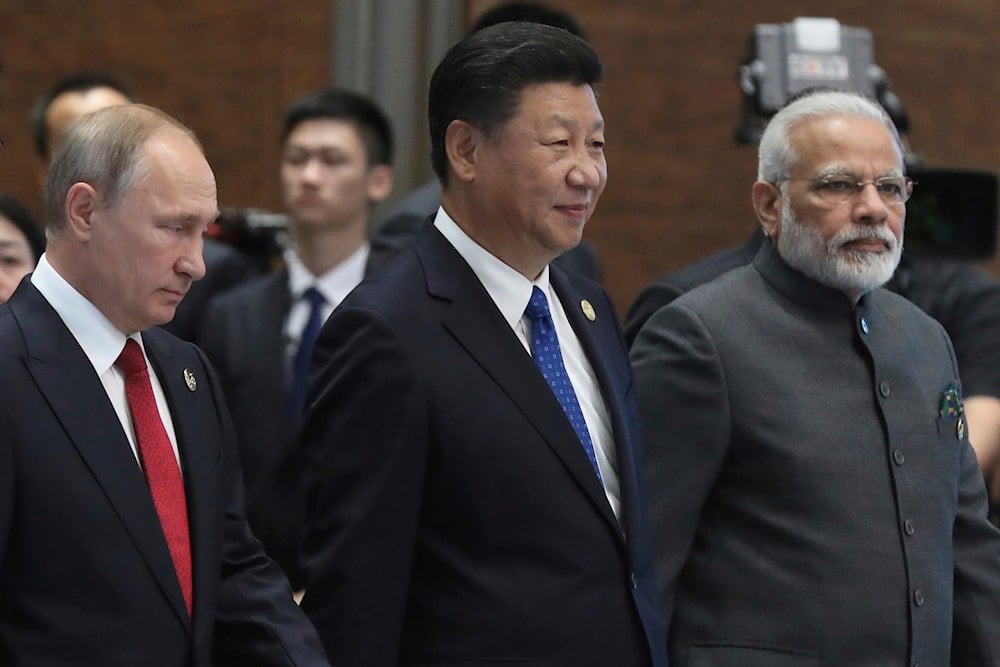Modi to visit China amid growing India-US trade rift
Modi to visit China and Japan amid escalating India-US trade tensions, signaling a strategic shift in global partnerships.
-

From left, Russian President Vladimir Putin, Chinese President Xi Jinping, and Indian Prime Minister Narendra Modi arrive for the Dialogue of Emerging Market and Developing Countries on the sidelines of the BRICS Summit in Xiamen, China, on September 5, 2017. (Wu Hong/Pool Photo via AP)
Indian Prime Minister Narendra Modi is set to land in Tianjin this weekend for his first visit to China in seven years. The trip coincides with growing India-US trade tensions, placing Modi alongside Chinese President Xi Jinping and Russian President Vladimir Putin at a crucial regional summit.
The visit comes just days after the US doubled tariffs on Indian exports, raising them to 50%. Washington cited New Delhi’s continued purchase of Russian oil as the reason behind the decision, an escalation that has disrupted years of growing cooperation between the two nations, particularly in the areas of technology and strategic alignment against Beijing.
According to South Asia analyst Michael Kugelman, the move has deeply damaged bilateral trust. "Indian trust in the US is shattered," he said, adding, "I’m not sure whether US officials fully realise how much trust they have squandered in such a short time."
Modi's presence at the Shanghai Cooperation Organisation (SCO) summit in Tianjin sends a strong diplomatic message. The summit is set to begin on Sunday and is expected to focus on regional security and economic collaboration.
Kugelman noted the geopolitical significance of the visit, "Modi will be in China at a moment when India-China relations are stabilising and India-US relations have gone south. It is a powerful optic."
Manoj Kewalramani, head of Indo-Pacific studies at the Takshashila Institution in Bengaluru, added, “No doubt there are some in China who are reveling in the trade tensions between India and the US.”
India-US trade tensions hit a new high
The US is India’s largest export destination, accounting for $86.5 billion annually. With nearly $60.2 billion of that now subject to higher tariffs, key labor-intensive sectors such as textiles and jewelry are set to suffer.
Amid the growing rift with Washington, India appears to be deepening its partnership with Russia. Putin, according to Kugelman, is likely to seize the moment to reinforce Moscow’s strategic ties with New Delhi, stressing, "It’s a great moment for everyone to stick out their tongues at Washington."
India views the relationship with Russia as vital, not only for balancing its diplomatic posture with the West but also for diversifying its military procurement and ensuring long-term energy security.
Modi is expected to meet with Xi on the sidelines of the SCO summit, with trade and investment high on the agenda. Kewalramani commented, "An effort is underway to see if India and China can reach some sort of new equilibrium. Both recognise that the world order is in flux."
India looks to Japan as US trade tensions escalate
Before heading to China, Modi will visit Tokyo on Friday for the annual India-Japan summit with Prime Minister Shigeru Ishiba, a meeting gaining weight amid rising India-US trade tensions.
India aims to strengthen ties with Japan in technology, defense, and investment to offset the impact of Washington’s tariffs. Japanese firms plan to invest up to ¥10 trillion ($68 billion) in India over the next decade, with Suzuki pledging $8 billion.
Following a tour of a Suzuki plant, Modi called Japan and India “partners made for each other.” Talks are expected to focus on rare earth cooperation and high-value manufacturing.
Despite the escalating trade dispute, Indian officials emphasize that New Delhi still values its partnership with Washington. However, they stress the need to diversify its global relationships to avoid overdependence on any single partner.
"India now cannot afford to appear as though it is giving in to US pressure on oil imports, or anything else that could be construed as a capitulation, and public anger is high," one Indian official noted.
In response to the tariffs, India has launched a sweeping export drive spanning 40 countries, from the UK to South Korea, to bolster its textile sector and minimize losses.

 4 Min Read
4 Min Read








